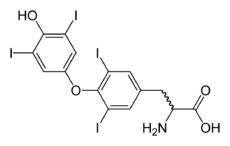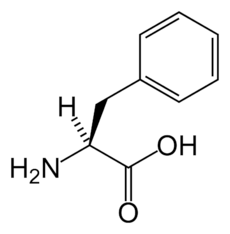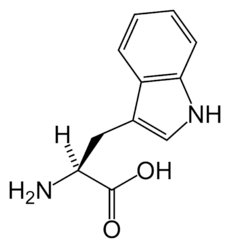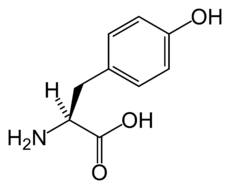Aromatic amino acids

Aromatic amino acids (AAA)[1] are amino acids that include an aromatic ring.
Examples include:
- Among 20 standard amino acids:
- Others:
- thyroxine
- 5-hydroxytryptophan
- L-DOPA
Phenylalanine → tyrosine → L-DOPA → (dopamine) → (epinephrine) → (norepinephrine)
Tryptophan → 5-hydroxytryptophan → (serotonin)
Phenylalanine → tyrosine → thyroxine
Phenylalanine, histidine, and tryptophan are essential amino acids for animals. Since they are not synthesized in the human body, they must be derived from the diet. Tyrosine is semi-essential; it can be synthesized, but only from phenylalanine. A lack of the enzyme phenylalanine hydroxylase, used in tyrosine synthesis, causes phenylketonuria, and concurrently renders tyrosine an essential amino acid.
All plants and micro-organisms must synthesize their aromatic amino acids through the shikimate pathway in order to make proteins, unlike animals, which obtain them through their diet. Because of the energy intensive nature of amino acid biosynthesis, animals have lost these costly metabolic pathways, since they can obtain aromatic amino acids by ingesting other organisms. Herbicides and antibiotics take advantage of this by inhibiting enzymes involved in aromatic acid synthesis, thereby rendering them toxic to plants and micro-organisms but not animals.
See also
External links
- Aromatic Amino Acids at the US National Library of Medicine Medical Subject Headings (MeSH)
References
Further reading
- Maeda, H.; Dudareva, N. (2012). "The Shikimate Pathway and Aromatic Amino Acid Biosynthesis in Plants". Annual Review of Plant Biology 63: 73–105. doi:10.1146/annurev-arplant-042811-105439. PMID 22554242.
| ||||||||||||




.svg.png)